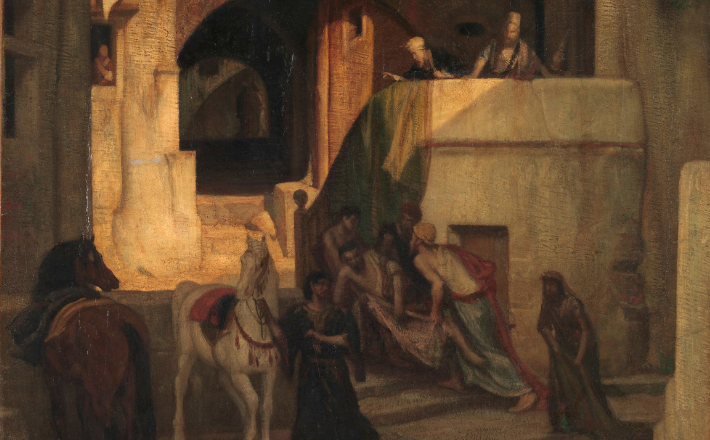Commentary on Colossians 1:1-14
Colossians 1:1–14 includes the greeting and thanksgiving of what we know as Paul’s letter to the Colossians. Among the 13 Pauline letters, Colossians is a disputed epistle. Importantly, “disputed” does not mean that Paul did not write a given letter; it simply means that a significant number of scholars dispute that Paul wrote it. Although there is no consensus on the matter, contemporary scholars increasingly believe Paul played at least some part in authoring Colossians. For simplicity, I refer to the author as Paul, though my discussion does not depend on a particular theory of authorship.
Colossians also fits the category of a Pauline prison letter (4:3), along with Ephesians, Philippians, and Philemon. If indeed Paul authored Colossians, it is not clear in which period of incarceration he did so. Additionally, Paul did not establish the community of Christ-believers in Colossae. Rather, they seem to have been evangelized by a man named Epaphras (1:7; see also 4:12), whom Paul also names as a fellow prisoner in Philemon 23. Paul is, therefore, removed from the Colossians’ experiences, and he writes based on what Epaphras reported to him (1:8).
In sum, Colossians presents itself as a letter from Paul, who is imprisoned, to a group of Christ-believers in Colossae. Paul is, therefore, a step removed from the Colossians’ experiences, and he writes based on information he received from Epaphras.
In the greeting (1:1–2), Paul refers to himself as “an apostle of Jesus Christ through the will of God” (my translation). Typically, Paul opens epistles by presenting himself in ways that are pertinent to particular occasions and useful for his rhetorical purposes. He introduces himself, for instance, as a “slave (doulos) of Christ Jesus” (Romans 1:1; Philippians 1:1 [plural]), an apostle (apostolos, Romans 1:1; 1 Corinthians 1:1; 2 Corinthians 2:1; Galatians 1:1; Ephesians 1:1; 1 Timothy 1:1; 2 Timothy 1:1), a prisoner (desmios, Philemon 1), or simply as Paul (1 Thessalonians 1:1).
In Colossians, Paul’s self-presentation simply as an apostle likely functions to underscore his apostolic authority, perhaps in anticipation of his later attempts to counter what he views as false teachings (see more below). Correspondingly, Paul addresses the Colossians as “the saints (hagios) and faithful brothers and sisters in Christ in Colossae” (1:2, New Revised Standard Version). There, one finds the only occurrence of Paul greeting a community as “siblings” (adelphois). That label at once acknowledges the audience as part of the larger “family of Christ” and places them on similar footing as “Timothy the brother” (1:1, my translation) in relationship both to Paul and to the wider network of believers who share familial relationships.1
Although the New Revised Standard Version adds punctuation to simplify Paul’s long and winding discourse, Colossians 1:3–8 comprises a single sentence in the Greek. As with the whole of 1:1–14, these verses anticipate themes that occur later in the epistle. For instance, Paul’s famous themes of faith, hope, and love (1 Corinthians 13:13) make an appearance.
He notes that he has “heard of [their] faith in Christ Jesus” (verse 4; see also 2:5, New Revised Standard Version). Later, he encourages them to “continue securely established and steadfast in the faith” (1:23). Paul has likewise heard of “the love [they] have for all the saints” (1:4; see also 1:8). In 3:14, he instructs the Colossians, “Above all, clothe yourself with love” (New Revised Standard Version). In 1:5, Paul mentions the “hope being stored away for you in the heavens” (my translation). Later, in the same statement in which Paul encourages them to continue “steadfast in the faith,” he adds, “without shifting from the hope promised by the gospel” (1:23).
These examples illustrate the “you have … but continue in” pattern that characterizes much of the letter: They have faith, and they should continue in the faith. They possess love and are continually to clothe themselves in it. Hope is stored for them in heaven, and they should remain in that hope.
Paul also establishes in 1:3–8 that the Colossians have heard about hope “in the word of truth, the gospel” (New Revised Standard Version). In 1:9–11, Paul references his prayers that the Colossians would “be filled with the knowledge of God’s will in all spiritual wisdom and understanding,” themes that also anticipate later discussions in the epistle (for knowledge [epignōsis], see also 1:10; 2:2; 3:10; on wisdom [sophia], see also 1:28; 2:3, 23; 3:16; 4:5; for understanding [sunesis], see also 2:2). These early references to truth, wisdom, knowledge, and understanding not only affirm his readers but seemingly function to prepare them for his later warnings and instructions about what he views as false teachings.
Concerning such teachings, Paul writes, for example, about the possibility of the Colossians being deceived by “plausible arguments” (2:4). He warns them not to be taken “captive through philosophy and empty deceit, according to human tradition, according to the elemental principles of the world, and not according to Christ” (2:8, New Revised Standard Version Updated Edition). He instructs them not to be condemned for “matters of food or drink or observing festivals, new moons, or Sabbaths,” not to be disqualified by those “insisting on self-abasement and worship of angels, initiatory visions,” or “puffed up without cause by a human way of thinking” (2:18–19, New Revised Standard Version Updated Edition).
Scholars have attempted to (re)construct the nature of the teaching or philosophy that some unknown group was sharing with the Colossians, if indeed there was a single group with one teaching. I caution against granting significant interpretive weight to such (re)constructions; our only evidence is from the epistle itself. Rather, my concern is with Paul’s rhetorical strategy in 1:1–14 of anticipating his later discussions: He does not begin by deconstructing the claims of specific alternative teachings; he emphasizes the gospel that the Colossians have received as a reminder about who they were and have become.
As he puts it, they have been “rescued … from the power of darkness” and “transferred … into the kingdom of [God’s] beloved Son” and are now, therefore, both redeemed and forgiven (1:13–14). Rhetorically, Paul grounds them in their reception and experience of the gospel that Epaphras taught them.
Notes
- Jerry L. Sumney, Colossians, The New Testament Library (Louisville: Westminster John Knox, 2008), 28.


July 13, 2025